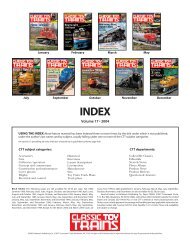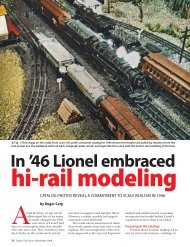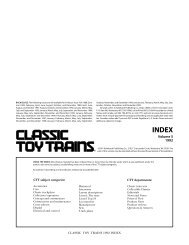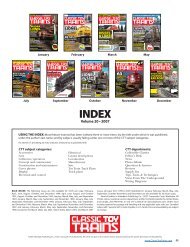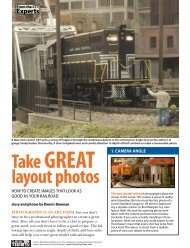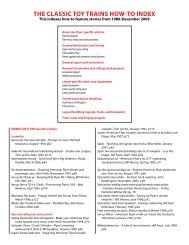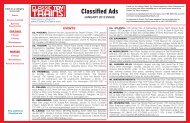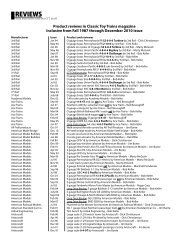A moveable O-gauge layout raises the bar - Classic Toy Trains
A moveable O-gauge layout raises the bar - Classic Toy Trains
A moveable O-gauge layout raises the bar - Classic Toy Trains
- No tags were found...
Create successful ePaper yourself
Turn your PDF publications into a flip-book with our unique Google optimized e-Paper software.
configuration, <strong>the</strong> largest to date.When basements and largegarages weren’t available (as was <strong>the</strong>case in San Diego and VirginiaBeach), I’ve sometimes assembledCONUS Lines in <strong>the</strong> living room.(Obviously, I have an understandingand tolerant family!). O<strong>the</strong>r timesI’ve installed a number of sections ina large O <strong>gauge</strong> modular club <strong>layout</strong>in a local shopping mall.As far as <strong>the</strong> ordeal of moving, it’snever what I would call “fun.” However,as long as all <strong>the</strong> <strong>layout</strong>’s structuresand scenery details areremoved (a six-week process withplenty of long nights and help fromall family members), I can wrap <strong>the</strong>modules in heavy blankets for transportwith little damage.Seasons and scenesBecause CONUS Lines is meantto be visitor friendly, I kept <strong>the</strong> aislesbetween modules at least three tofour feet in width. That gives guestsroom to enjoy my particular emphasison <strong>the</strong> kinder, gentler aspects ofscale model railroading: realisticscenery and structures, and plenty ofpeople and animals. Despite my <strong>layout</strong>’sability to change settings, mostelements of scenery are relativelypermanent and offer even more varietyfor visitors who might enjoy achange in seasons.At present, all four seasons arerepresented in <strong>the</strong> 21st century versionof CONUS Lines. Springblooms on six modules comprising<strong>the</strong> whistle stop of Prairie View. Summershines in <strong>the</strong> four mountainmodules comprising Sierra Crossing.6. Snow has fallen on <strong>the</strong> lower level ofCumberland’s business district, which includesa Downtown Deco newsstand and <strong>bar</strong>ber shopand a Wal<strong>the</strong>rs Cornerstone building modifiedto create Yummie’s Donuts. Inside <strong>the</strong> donutshop, you might be surprised to find that <strong>the</strong>customers are regulars at Moe’s <strong>bar</strong> of TheSimpsons TV show fame, made possible by ascanned computer image.5 steps to hi-railWHAT IS O GAUGE hi-rail? The termis used often, but its exact meaningis sometimes open to debate.When I say “hi-rail,” I’m thinkingabout <strong>the</strong> definition I’ve read inRealistic Railroading with <strong>Toy</strong> <strong>Trains</strong>by Joe Lesser and Pete Youngblood(Greenberg Books, 1995).Hi-railing: A term used to denote toytrain operators who combine scale andnon-scale three-rail trains with a consciouseffort to achieve greater realism.With that definition in mind, Ioffer five easy steps you can take onyour <strong>layout</strong> to cross over into <strong>the</strong>world of O <strong>gauge</strong> hi-rail.1Slow down! Operate trains atprototypical speeds. The increasein realism is accentuated by soundsystems that reflect how fast <strong>the</strong>wheels are turning on a locomotiveand synchronous smoke systemswith prodigious smoke. Nothingimproves realism more than hearing,as well as seeing, a mammotharticulated laboring upgrade atclose to stall speed with a dozenhoppers, or a G-5 steam engineslowly accelerate a string of Madisoncars out of <strong>the</strong> station.2Wea<strong>the</strong>r everything. Granted,this is a lot easier to commit toon a $25 hopper than it is an $800Daylight, but you can at least apply alight application of Testor’s Dullcote(or a similar flat clear lacquer)to remove <strong>the</strong> shine. My favoritetechnique involves washes of paints.With an airbrush, I apply FloquilGrimy Black diluted 10-to-1 withDioSol (Floquil’s lacquer solvent) tomake that rolling stock look welltraveled. Grimy Black is also greatfor staining GarGraves wooden tiesand roadbed. Mixed with FloquilRoof Brown, it makes an excellentwea<strong>the</strong>r medium for virtually allstructures. Stay away from pureblacks, whites, and reds; a fewshades off <strong>the</strong>se traditional colorswill work wonders in achieving thatrealistic effect.3Match everything. You can “hirail”in scale-oriented 3-rail O<strong>gauge</strong> models, traditional O <strong>gauge</strong>models, and even O-27 models. Justdon’t mix <strong>the</strong> various pieces in atrain. A traditional Lionel no. 2055steam locomotive running down <strong>the</strong>main with a brace of 6464 boxcarslooks as “right” as a scale MTH PremierSP Cab-Forward with a longcut of Crown and Weaver woodsidedreefers. Remember: All thingsare relative!4Learn to love <strong>the</strong> color brown.Until <strong>the</strong> late 1960s, brown (invarious shades and hues) was <strong>the</strong>color of choice for most of <strong>the</strong>nation’s rolling stock. Hi-railing O<strong>gauge</strong>rs who favor <strong>the</strong> steam-todieseltransition period should alsofollow suit. Most color images ofthis era show long strings of freight,mostly in boxcars, in Freight CarRed, Tuscan, or Mineral Red, naturallywea<strong>the</strong>r worn and stained byuse. Bright colors sell models in <strong>the</strong>marketplace, but plenty of “brownish”models are available. And anairbrush and decals or dry transferscan do wonders for making a “correct”consist to run behind thosePennsy Centipedes you just bought!5Look, listen, and learn. Booksand videotapes can help youlearn more about realism, whe<strong>the</strong>rit is concerning equipment,scenery, operation, or <strong>layout</strong> design.The marketplace is full of how-tomodel railroading guides and colorphotoprototypebooks depicting aparticular railroad,era, or geographicregion. RealisticRailroading with <strong>Toy</strong><strong>Trains</strong> (where myhi-railing definitioncomes from), is myparticular favorite.For a more detaileddiscussion of myapproach to <strong>layout</strong>design and operation,read “DominoPlanning Basics,”an article by DavidHi-railing:A term used todenote toy trainoperators whocombine scale andnon-scale three-railtrains with aconscious effort toachieve greaterrealism.Barrow in Model Railroad Planning1999 (Kalmbach Publishing Co.).Videotaped reference sourcesinclude Allen Keller’s Great ModelRailroads series.I think you’ll find that <strong>the</strong>resources to add realism to toytrains are almost endless for <strong>the</strong>aspiring hi-railer. – Rick WrightN OVEMBER 2000 • CLASSIC T OY T RAINS 55




